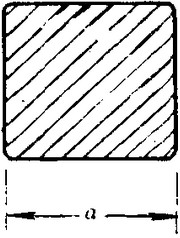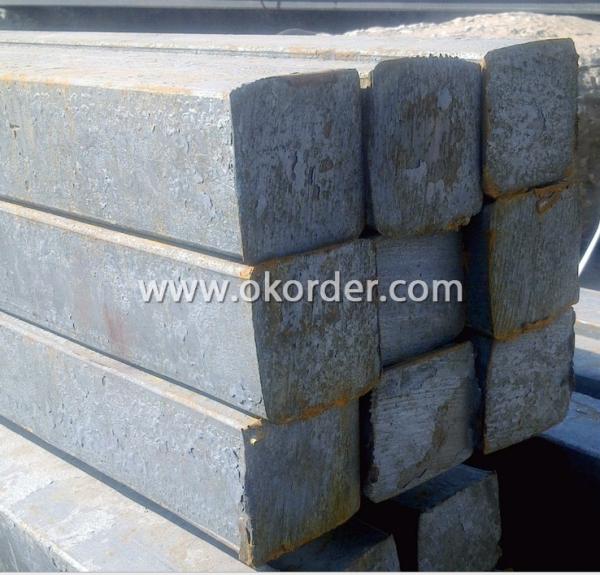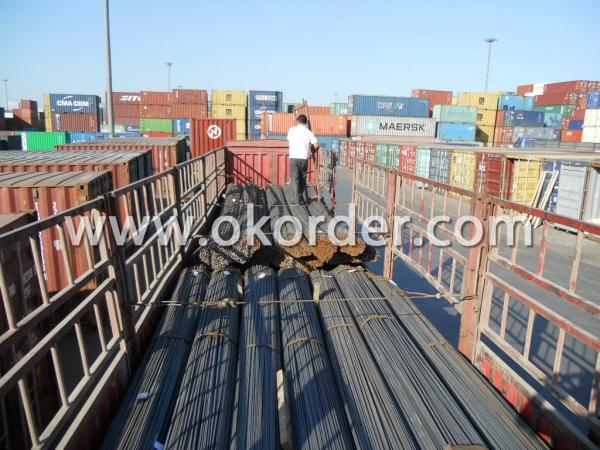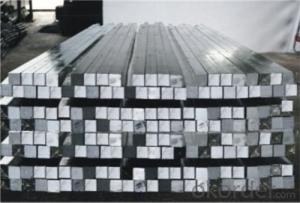Hot-rolled Square Steel Bar
- Loading Port:
- Tianjin Port
- Payment Terms:
- TT or LC
- Min Order Qty:
- 50Tons m.t.
- Supply Capability:
- 500 tons per month m.t./month
OKorder Service Pledge
OKorder Financial Service
You Might Also Like
There are two types of Square Bar, one is hot rolled square bar and other one is cold drawn square bar. Our principal products is hot rolled square bar. We dedicate to products with material Q195 and Q235. We offer products with high quality and low price.
Specifications of Hot-rolled Square Steel Bar:
-Standard: GB,
-Grade: Q195/Q235 or equivalent.
-Chemical Composition:
|
Standard |
Grade |
Element (%) | ||||
|
C |
Mn |
S |
P |
Si | ||
|
GB |
Q195 |
0.06~0.12 |
0.25~0.50 |
≤0.050 |
≤0.045 |
≤0.30 |
|
GB |
Q235B |
0.12~0.20 |
0.30~0.70 |
≤0.045 |
≤0.045 |
≤0.30 |
-Mechanical Properties:
|
Mechanical Properties |
Grade |
Steel diameter(mm) | |||
|
≤16 |
16~40 |
40~60 |
60~100 | ||
|
Yield Point Δs/MPa |
Q195 |
≥195 |
≥185 |
- |
- |
|
Q235 |
235 |
225 |
215 |
205 | |
|
Tensile Strength |
Q195 |
315~390 | |||
|
Q235 |
375~500 | ||||
|
Elongation δ5% |
Q195 |
≥33 |
≥32 |
- |
- |
|
Q235 |
26 |
25 |
24 |
23 | |
Measures of Hot-rolled Square Steel Bar (Big measures):

(Section of Hot-rolled Square Steel Bar)
-Length of a side and Theoretical weight of Square Bar (Big measures).
|
Length of a side(mm) |
Theoretical weight(kg/m) |
Length of a side(mm) |
Theoretical weight(kg/m) |
|
53 |
22.05 |
80 |
50.24 |
|
56 |
24.61 |
85 |
56.72 |
|
60 |
28.26 |
90 |
63.59 |
|
63 |
31.16 |
95 |
70.85 |
|
70 |
38.49 |
100 |
78.50 |
|
75 |
44.16 |
|
|
Notes:
1, The theoretical weights in the list, base on the density of 7.85 g/cm3.
2, Formula for theoretical weight of Square bar: a(length of a side) * a * 0.00785
3, The numbers with *mean that they are not regular or we don’t offer them.
-Regular length of Square Bar:
|
Steel |
Length of a side (mm) |
Length of steel (m) |
|
Normal steel |
< 25 |
4~10 |
|
> 25 |
3~9 | |
|
Steel of high quality |
All measure |
2~6 |
|
Tool steel >75 |
1~6 |
Usage/Applications of Hot-rolled Square Steel Bar:
-The Square Steel is normally used as structure steel.
-Row material for other structure steel like steel angles, channels, I-beams, H-beams, etc…
-Row material for steel pipes.
Packaging & Delivery of Hot-rolled Square Steel Bar:
-Packing Detail:
1, The products can be packed in bundles by steel wires.
2, The weight of each bundle no exceed normally 3 tons.
-Marks: We make tag marks and color marks for each bundle. The tag marks with white background and red company log will be tied up to each bundle. The information is usually including basic information of company and products like product name, specification, etc...and other information required by customers. As for color marks, we will paint both ends of each bundles to make sure that it will be more convenient for customers to distinguish theme from other products.
-Delivery Detail: 30~45 working days after receive buyer’s T.T. or L/C.
Payment:
-Invoicing on theoretical weight or actual weight as customer’s request.
-FOB, CFR or CIF.
-Regular terms of payment:
1, 30% payment in advance, the remaining balance (70% payment) against the copy of B/L.
2, 30% payment in advance, the remaining balance (70% L/C) against the copy of B/L.
3, Negotiable.
-The payment terms will be written in contraction detailedly.
Photos of Hot-rolled Square Steel Bar:


We sincerely welcome partners around the world to establish business cooperation with us on the basis of mutual trust, benefit and development.
- Q:Can a steel square be used for fence post layout?
- Yes, a steel square can be used for fence post layout.
- Q:How do you use a steel square to check for levelness?
- To use a steel square to check for levelness, you would first start by placing the square on the surface you want to check. Ensure that the square is positioned firmly and evenly on the surface. Next, observe the bubble level on the square. The bubble level is typically located in the center of the square. It is a small glass tube with a liquid and an air bubble inside. The bubble should be between two marked lines or in the center of the tube if it is a digital level. If the bubble is centered between the lines or in the middle of the tube, it indicates that the surface is level horizontally. If the bubble is not centered and leans towards one side, it means the surface is not level and needs adjustment. To level the surface, you can use shims or adjust the legs or supports under the surface until the bubble is centered. You can also use the square as a guide to measure the difference in height or levelness across different points of the surface. Keep in mind that a steel square is typically used for smaller, more precise leveling tasks. For larger surfaces or more accurate measurements, a longer level or laser level might be more appropriate.
- Q:How do you use a steel square for marking perpendicular lines?
- To use a steel square for marking perpendicular lines, place the long side of the square against the edge of the material you want to mark. Then, align the short side of the square with the edge of the material, making sure it forms a right angle with the long side. Finally, use a pencil or marking tool to trace along the edge of the short side, creating a straight and perpendicular line.
- Q:Can a steel square be used for laying out rafters?
- Yes, a steel square can be used for laying out rafters. A steel square, also known as a framing square, is a versatile tool commonly used in carpentry and construction. It consists of a long arm and a shorter arm, both at a 90-degree angle, allowing for accurate measurements and markings. When it comes to laying out rafters, a steel square can be used to determine the angles and lengths required for each rafter. By utilizing the various measurements and markings on the square, carpenters can easily determine the pitch, length, and angles needed for the rafters, ensuring a precise and efficient layout. The steel square can be used to make plumb cuts for the ridge board and seat cuts for the birds-mouth on each rafter. Additionally, it can be used to determine the angles for the birdsmouth cut, which is necessary to properly fit the rafter onto the top plate of the wall. By utilizing the steel square, carpenters can ensure that each rafter is accurately cut and positioned for a structurally sound roof. Overall, a steel square is an essential tool for laying out rafters. Its versatility and accuracy make it a reliable choice for carpenters and construction professionals, allowing for precise measurements and markings necessary for a well-constructed roof.
- Q:What are the different types of steel used in manufacturing steel squares?
- Manufacturing steel squares involves the use of various types of steel, each possessing distinct properties and characteristics. Firstly, there is carbon steel, which is the most commonly utilized steel in this process. It is a versatile material that strikes a good balance between strength and cost-effectiveness. Carbon steel squares are known for their durability and ability to withstand heavy usage. Secondly, stainless steel is employed due to its resistance to corrosion and high strength. Industries that prioritize hygiene and cleanliness, such as food processing or medical equipment manufacturing, often rely on stainless steel squares. Next, alloy steel squares are created by incorporating additional elements like chromium, molybdenum, or nickel into carbon steel. This results in enhanced strength, toughness, and resistance to wear. Alloy steel squares find application in areas requiring durability and high strength, such as construction or automotive manufacturing. Tool steel squares are specifically designed for cutting, shaping, or forming other materials. They possess excellent hardness, wear resistance, and heat resistance. Industries involved in tool and die making, machining, or metalworking frequently utilize tool steel squares. Lastly, high-speed steel squares, a type of tool steel, are engineered to endure high temperatures and cutting speeds. These squares are commonly employed in high-speed machining or cutting applications like drilling or milling. Ultimately, the choice of steel for manufacturing steel squares relies on the specific requirements and intended applications. Each type of steel offers distinct properties that enhance the performance and durability of the steel squares.
- Q:Can a steel square be used for measuring the width of a wall opening?
- Yes, a steel square can be used for measuring the width of a wall opening. Its straight edges and right angles make it suitable for measuring and marking precise measurements on walls and other surfaces.
- Q:How do you use a steel square for marking roof dormer angles?
- To use a steel square for marking roof dormer angles, first, position the square on the edge of the roof, aligning one leg with the roof's pitch. Then, rotate the square until the other leg matches the desired angle for the dormer. Finally, mark the angle on the roof using a pencil or marker, ensuring accurate measurements for the dormer construction.
- Q:How do you use a steel square to lay out a pentagon?
- To use a steel square to lay out a pentagon, you would need to follow a specific set of steps. Here's a guide to help you with the process: 1. Begin by determining the desired size of the pentagon. You need to know the length of one side or the apothem (the distance from the center to any side) in order to proceed. 2. Set your steel square on a flat surface, ensuring it is aligned properly. 3. Measure the desired length of one side of the pentagon on the steel square's blade. Mark this measurement with a pencil or any suitable marking tool. 4. Place the blade of the square at the desired starting point for the pentagon's construction. Ensure that the marked measurement aligns with the starting point. 5. Hold the steel square firmly in place and pivot it around the starting point, creating an arc. 6. Repeat step 5 by pivoting the square around the arc's endpoint, creating another arc that intersects the first one. 7. Continue this process, pivoting the square along the intersecting arcs, until you have five intersecting arcs. 8. Connect the points where the arcs intersect to form the sides of the pentagon. 9. Once the pentagon's sides are marked, double-check the angles to ensure they are all 108 degrees. Adjust if necessary. 10. Finally, use a ruler or straight edge to connect the marked points, forming the complete pentagon shape. Using a steel square to lay out a pentagon requires precision and careful measurements. By following these steps, you can accurately construct a pentagon using this versatile tool.
- Q:What are the markings on a steel square used for?
- The markings on a steel square are used for a variety of purposes in carpentry and other construction-related tasks. These markings help in accurately measuring and marking angles, distances, and dimensions while working with wood, metal, or other materials. The most common markings found on a steel square are the graduations along the edges. These graduations are usually in inches, centimeters, or both, and are used to measure lengths and distances. They allow carpenters to quickly and accurately determine the dimensions of a piece of material or the spacing between two points. In addition to the graduations, a steel square also has markings to measure angles. The most notable angle markings are the 45-degree and 90-degree angles. These angles are crucial in creating precise right angles and bevels, which are essential for constructing square and symmetrical structures. Furthermore, a steel square often includes a protractor scale. This scale allows for measuring and marking angles other than 45 and 90 degrees. This feature is particularly useful when working on projects that require specific angles, such as roof structures or staircases. Some steel squares also have additional markings, such as rafter tables or conversion charts. These markings provide specific measurements and calculations for various construction tasks, saving time and reducing the need for manual calculations. Overall, the markings on a steel square serve as a versatile and reliable tool for carpenters and builders. They enable accurate measurements, precise marking of angles, and efficient calculations, making the steel square an essential tool in construction projects.
- Q:How do you use a steel square to lay out a stair stringer?
- In order to lay out a stair stringer using a steel square, the following steps should be followed: 1. Collect the necessary tools: a steel square, a tape measure, a pencil, a framing square, and a saw. 2. Begin by determining the total rise of the stairs. Measure the vertical distance from the finished floor at the bottom to the finished floor at the top of the stairs. This measurement will establish the required number of risers. 3. Establish the desired height for each riser. Building codes generally mandate a riser height ranging from 6 to 8 inches. Divide the total rise by the desired riser height to calculate the number of risers needed. 4. Subsequently, ascertain the tread depth. Building codes typically demand a tread depth between 9 and 11 inches. Measure the horizontal distance between the finished floor at the bottom and the finished floor at the top of the stairs. Divide this measurement by the number of treads to determine the tread depth. 5. Position the framing square on the edge of the stringer, aligning the heel of the square with the bottom of the stringer and the blade with the tread depth measurement. Proceed to mark a line along the blade of the square. 6. Shift the square up to the top of the stringer, aligning the heel with the top and the blade with the riser height measurement. Proceed to mark a line along the blade of the square. 7. Connect the two lines marked on the stringer to outline the shape of the stringer. Utilize a straight edge to ensure the lines are straight and perpendicular. 8. Repeat this procedure for the desired number of stringers, usually two for a standard staircase. 9. Employ a saw to cut along the lines marked on the stringer, thereby creating the stair stringer. By adhering to these steps and utilizing a steel square, one can accurately lay out a stair stringer and guarantee the construction of a secure and properly aligned staircase.
1. Manufacturer Overview |
|
|---|---|
| Location | Renqiu, China |
| Year Established | 1996 |
| Annual Output Value | Above US$ 30 Million |
| Main Markets | Mid East; Southeast Aisa |
| Company Certifications | |
2. Manufacturer Certificates |
|
|---|---|
| a) Certification Name | |
| Range | |
| Reference | |
| Validity Period | |
3. Manufacturer Capability |
|
|---|---|
| a)Trade Capacity | |
| Nearest Port | Tianjin; |
| Export Percentage | 20% - 30% |
| No.of Employees in Trade Department | 11-20 People |
| Language Spoken: | English; Chinese |
| b)Factory Information | |
| Factory Size: | Above 70,000 square meters |
| No. of Production Lines | 1 |
| Contract Manufacturing | OEM Service Offered |
| Product Price Range | Average |
Send your message to us
Hot-rolled Square Steel Bar
- Loading Port:
- Tianjin Port
- Payment Terms:
- TT or LC
- Min Order Qty:
- 50Tons m.t.
- Supply Capability:
- 500 tons per month m.t./month
OKorder Service Pledge
OKorder Financial Service
Similar products
New products
Hot products
Hot Searches
Related keywords


























